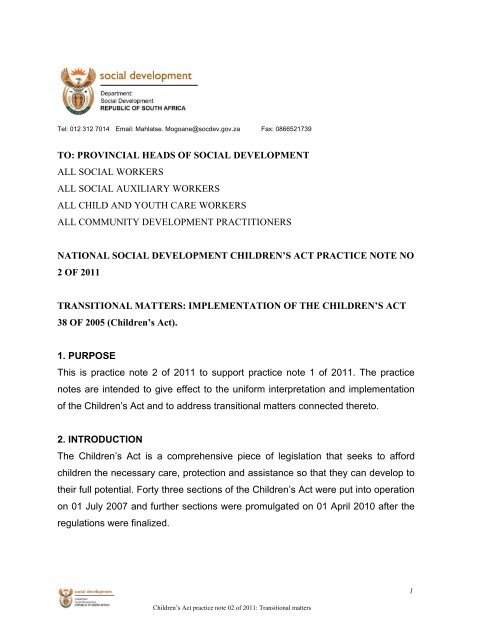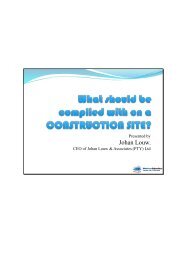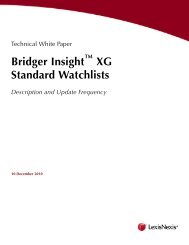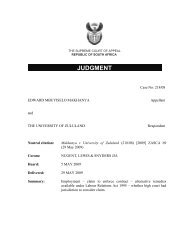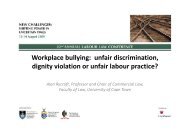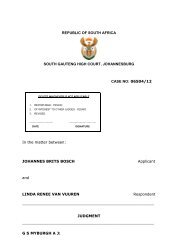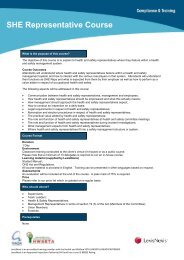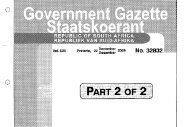Children's Act Practice Note 2 of 2011 - LexisNexis South Africa
Children's Act Practice Note 2 of 2011 - LexisNexis South Africa
Children's Act Practice Note 2 of 2011 - LexisNexis South Africa
You also want an ePaper? Increase the reach of your titles
YUMPU automatically turns print PDFs into web optimized ePapers that Google loves.
8. Who is an appropriately trained person?Legal positionSection 132 indicates that a child may only be tested for HIV after propercounseling, by an appropriately trained person. The <strong>Act</strong> does not indicate whatan appropriately trained person is.<strong>Practice</strong> positionFor the purpose <strong>of</strong> implementing the Children’s <strong>Act</strong> in a uniform manner anappropriately trained person will refer to a person who is familiar within the field <strong>of</strong>HIV/AIDS, has completed an HWSETA accredited course in HIV/AIDS counselingand is familiar with the Health Policy on testing <strong>of</strong> persons for HIV/AIDS. In additionto the above for the purpose <strong>of</strong> implementing the <strong>Act</strong> an accredited course inHIV/AIDS counseling will refer to attendance <strong>of</strong> at least a 3 day training whichincluded four or more <strong>of</strong> the following topics and was issued a certificate <strong>of</strong>attendance.• Introduction to HIV and AIDS• Counseling• Pre and Post test Counseling• Psychosexual issues in Counseling and Testing• Legal and Ethical issues• Mother to Child Transmission• Antiretroviral treatment• Condomisation• Post exposure prophylaxis“Appropriately trained” was meant for practitioners involved in children’s matters tobe acquainted with the necessary skills through training to ensure that the childconcern is receiving the highest quality <strong>of</strong> services without being exposed tosecondary trauma due to the lack <strong>of</strong> knowledge and understanding.Child Protection workers can request their HIV/AIDS Directorates to provide thistraining to them. If not available the Department <strong>of</strong> Health also provides similar6Children’s <strong>Act</strong> practice note 02 <strong>of</strong> <strong>2011</strong>: Transitional matters
11. Removal <strong>of</strong> child to temporary safe care by court orderLegal positionSection 151 (Non-urgent removals) Regulation 53 and 54.The presiding <strong>of</strong>ficer can issue an order after listening to evidence given beforehim/her by any person on oath or affirmation that a child appears to be in need <strong>of</strong>care and protection. And further than that, the presiding <strong>of</strong>ficer must order that adesignated social worker investigate and compile a report on the circumstances <strong>of</strong>the child in terms <strong>of</strong> section 155(2) before issuing a court order.The issued court order may stipulate that the child be placed in temporary safecare if it is necessary for the safety and well being <strong>of</strong> the child, (section151(2)).A person authorised to remove the child may, either alone or accompanied by thepolice <strong>of</strong>ficial:-enter any premises mentioned in the order;- remove the child from the premises; and-on those premises exercise any power mentioned in section 50(3)(a) to (d) whichis to remove the child, investigate the circumstances <strong>of</strong> the child, record anyinformation and carry out any specific instruction <strong>of</strong> the court.Section 151 (6) empowers the police <strong>of</strong>ficial who may accompany the personauthorized to remove the child, to “use such force as may be reasonably necessaryto overcome any resistance against the entry <strong>of</strong> the premises contemplated insection 151 (5)(a), including the breaking <strong>of</strong> any door or window <strong>of</strong> such premises:Provided that the police <strong>of</strong>ficial shall first audibly demand admission to thepremises and notify the purpose for which he or she seeks to enter suchpremises.”Section 151 (7) states that:“The person who has removed a child in terms <strong>of</strong> the court order must—(a) without delay but within 24 hours inform the parent, guardian or care-giver <strong>of</strong>the child <strong>of</strong> the removal <strong>of</strong> the child, if that person can readily be traced; and9Children’s <strong>Act</strong> practice note 02 <strong>of</strong> <strong>2011</strong>: Transitional matters
13. Advertising <strong>of</strong> abandoned or orphaned childrenLegal positionRegulation 56 (1). If it appears to a designated social worker that a child has beenabandoned or orphaned, whether for purposes <strong>of</strong> determining if such child is inneed <strong>of</strong> care and protection or if such child can be made available for adoption,such social worker must cause an advertisement to be published in at least onelocal news paper circulating in the area where the child has been found callingupon any person to claim responsibility for the child.<strong>Practice</strong> positionTo advertise abandoned or orphaned children in a news paper kindly use theattached templates. Annexure R-Publication <strong>of</strong> abandoned or orphaned childwith identifying particulars which should be used in cases where there isinformation available about the concerned child and/or his/her family whereasAnnexure S-Publication <strong>of</strong> abandoned or orphaned child without identifyingparticulars which should be used if there are no identifying particulars <strong>of</strong> theconcerned child or his/her family.Provinces must customise these templates and circulate to your counterparts (Districts and NGOs)If the presiding <strong>of</strong>ficer decides to use section 45 and 46 there may not be a need toadvertise as regulation 56 makes reference to bringing the orphaned child beforethe court for purposes <strong>of</strong> finding the child in need <strong>of</strong> care and protection andsection 46 does not require that the child be found in need <strong>of</strong> care according tosection 156. However, if the presiding <strong>of</strong>ficer decides to use section 156 to presideover the case, then the advertisement must be done as it will contribute towardsdetermining that the child is need <strong>of</strong> care and protection.The <strong>Act</strong> does not make reference to an advertisement <strong>of</strong> foster children forpurposes <strong>of</strong> extending orders.Children’s <strong>Act</strong> practice note 02 <strong>of</strong> <strong>2011</strong>: Transitional matters14
14. Determining factors for a child to be placed in alternative careLegal position: Section 45, 46, 150, 155 and 156A child can be placed in alternative care after being found to be in need <strong>of</strong> care andprotection in terms <strong>of</strong> section 150, or the children’s court could adjudicate theprotection and well being <strong>of</strong> a child in terms <strong>of</strong> section 45 and can make an order interms <strong>of</strong> section 46(1).Working with a child who should be placed in alternative care, a designated socialworker will have two options in how to approach the Children’s Court.• The first option will be to find the child in need <strong>of</strong> care and protectionaccording to section 150(1). The court will then follow procedures as set outin section 155 (including a social work report, Form 38) and make anappropriate order according to section 156.• The second option is for a social worker to approach the Children’s Court interms <strong>of</strong> section 53. The social worker will then give evidence in the form<strong>of</strong> a report according to section 60(1) (a). It is recommended that socialworkers will use Form 38, as used in terms <strong>of</strong> section 155(2).Section 45 state that, the court may adjudicate any matter involving:(a) the protection and well-being <strong>of</strong> a child(g) the temporary safe care <strong>of</strong> a child(h) alternative care <strong>of</strong> a childThe court may then make orders in terms <strong>of</strong> section 46, which includes analternative care order (section 46(1)(a)). When using these sections a child is notfound to be in need <strong>of</strong> care and protection, but it focuses on the protectionand well being concept <strong>of</strong> the child to make an appropriate order in terms <strong>of</strong>section 46. The best interest <strong>of</strong> child standard principle is also applicable in thissituation.Children’s <strong>Act</strong> practice note 02 <strong>of</strong> <strong>2011</strong>: Transitional matters15
<strong>Practice</strong> positionWhen attending to a child, the social worker should do everything in her power toassist the child and make the best possible recommendation which will be in thechild’s best interest.Risk assessment is a critical component to the follow up <strong>of</strong> allegations <strong>of</strong> childabuse and neglect and it can be construed as an ongoing activity from thecommencement <strong>of</strong> the process <strong>of</strong> receiving reports <strong>of</strong> alleged abuse and decidingon action to be taken. It lays the foundation for proper investigation, follow up andultimate reporting to children’s courts, to enable the presiding <strong>of</strong>ficer to makesound decisions based on ecologically valid (the child within its family andenvironment setting), evidence based, criteria.Risk assessment is addressed in section 142(c) <strong>of</strong> the <strong>Act</strong> and in regulation 35,and it informs decision making and action. The aim <strong>of</strong> the broad risk assessmentframework is to provide guidelines for:• identification <strong>of</strong> children who are being abused or deliberately neglected• assessment <strong>of</strong> risk factors• investigation• appropriate protective measuresThe broad risk assessment framework includes the following guidelines:• the presence <strong>of</strong> indicators <strong>of</strong> physical abuse• the presence <strong>of</strong> indicators <strong>of</strong> sexual abuse• the presence <strong>of</strong> emotional and behavioural indicators <strong>of</strong> physical,psychological or sexual abuse• the presence <strong>of</strong> developmental indicators <strong>of</strong> physical, psychological orsexual abuse• the presence <strong>of</strong> indicators <strong>of</strong> deliberate neglect• a disclosure <strong>of</strong> abuse or deliberate neglect by the child; or• a statement relating to a pattern or history <strong>of</strong> abuse or deliberate neglectfrom a witness relating to the abuse <strong>of</strong> the child16Children’s <strong>Act</strong> practice note 02 <strong>of</strong> <strong>2011</strong>: Transitional matters
It is difficult to find a balance between over reacting or under reacting whendeciding if a child’s behaviour is abuse reactive or just problematic due toenvironmental factors. For this reason it’s important that as a social worker youhave clear understanding <strong>of</strong> the signs and symptoms <strong>of</strong> all types <strong>of</strong> abuse, as wellas the normal developmental and behavioural responses <strong>of</strong> children.Risk assessments should be well planned as time is <strong>of</strong> the essence. Ignorance <strong>of</strong>the risk to the child due to high workload is inexcusable. Ensure that youinvestigated properly before any allegations are made.Bear in mind that many indicators may be non-specific to abuse or neglect. Acluster or pattern <strong>of</strong> indicators as opposed to a single isolated indicator will providesupport for a conclusion <strong>of</strong> abuse or neglect;While doing the risk assessment, consider the following:• information about specific times <strong>of</strong> any incidents, places where incidentshave taken place and the context within which incidents have taken place,which must be noted in writing, may provide support for a conclusion <strong>of</strong>abuse or neglect;• abuse may be unintentional, but failure on the part <strong>of</strong> the parent or caregiverto prevent abuse <strong>of</strong> the child may amount to neglect;• abuse may be physical, psychological or sexual without any visibleindicators and is likely to exist if the child continuously reports threats <strong>of</strong>harm or punishment;• a series <strong>of</strong> minor incidents, any <strong>of</strong> which may, when considered in isolation,not amount to abuse or neglect, may constitute abuse or neglect whenconsidered together;• the child’s age, personality and temperament should be taken into account;• discrepancies in the rendition <strong>of</strong> incidents by the child and his or her parentor care-giver may either provide or diminish support for a conclusion <strong>of</strong>abuse or neglect; andChildren’s <strong>Act</strong> practice note 02 <strong>of</strong> <strong>2011</strong>: Transitional matters17
• any unexplained delay in seeking medical treatment for a child who isseriously injured, should be examined as a possible indicator <strong>of</strong> abuse orneglect.Annexure B <strong>of</strong> the Children’s <strong>Act</strong> (National Norms and Standards as part <strong>of</strong> theChildren’s <strong>Act</strong> Part III), provides for the National Norms and Standards for childprotection. Point 2 also provides specifics when doing assessment <strong>of</strong> children whohave been abused or deliberately neglected.Additional service specific Norms and Standards in terms <strong>of</strong> the Children’s <strong>Act</strong>were also developed (Norm 105, page 194), the following needs to be noted:• Risk assessment must be conducted for all children under the age <strong>of</strong> 18within the household and completed on a standardised form.• The risk assessment framework must guide decision-making in terms <strong>of</strong>child protection services.• Only designated social workers may conduct the risk assessment.• Each child must be assessed individually and within 48 hours uponreceipt <strong>of</strong> reports <strong>of</strong> abuse or deliberate neglect. Victims <strong>of</strong> rape should betaken to the doctor within 72 hours and be regarded as the highest priority.• The outcome <strong>of</strong> the risk assessment must indicate high, medium or low risk.• The outcome <strong>of</strong> the risk assessment must indicate the appropriateprotective measures <strong>of</strong> interventions.15. A child in need <strong>of</strong> care and protectionLegal positionSection 150 (1)(a) identifies a child who is in need <strong>of</strong> care if the child has beenabandoned or orphaned and is without visible means <strong>of</strong> support. The Child Care<strong>Act</strong> 83 <strong>of</strong> 1974 provided for an abandoned, orphaned child or a child without visiblemeans <strong>of</strong> support. Hence the interpretation <strong>of</strong> this clause by presiding <strong>of</strong>ficersmean that the child should be both abandoned/orphaned and without visible means<strong>of</strong> support.Children’s <strong>Act</strong> practice note 02 <strong>of</strong> <strong>2011</strong>: Transitional matters18
The Department <strong>of</strong> Justice sought for a legal opinion from the State Law Advisor inthis regard. The State Law Advisor’s opinion was that the presiding <strong>of</strong>ficers makeuse <strong>of</strong> section156 <strong>of</strong> the Children’s <strong>Act</strong> to determine if a child is in need <strong>of</strong> care andprotection, that is, availability <strong>of</strong> income <strong>of</strong> the prospective foster parent must notbe a determining factor for approval <strong>of</strong> foster care grant. However, presiding<strong>of</strong>ficers may still use their own discretion. (See attached circular-Annexure T-Legal opinion on interpretation <strong>of</strong> s150).<strong>Practice</strong> positionThe legal opinion confirms that children, who live with someone who receives anold age grant, do have visible means and can therefore not be seen as a child inneed <strong>of</strong> care and protection. However the State Law Advisor suggested thatpresiding <strong>of</strong>ficers may exercise their wide adjudicative powers, that is, they canuse their own discretion to apply section 45 and 46 <strong>of</strong> the Children’s <strong>Act</strong>. An ordercan be made in terms <strong>of</strong> section 46(1)(a)(i), placing a child in the care <strong>of</strong> a persondesignated by the court to be the foster parent <strong>of</strong> the child.A person designated by the court to be the foster parent <strong>of</strong> the child would thusbe eligible for a foster child grant in respect <strong>of</strong> the foster child in terms <strong>of</strong> section 8<strong>of</strong> the Social Assistance <strong>Act</strong>.This opinion is also shared with other authors <strong>of</strong> the Training guidelines for theChildren’s <strong>Act</strong> “Advanced phase: Child Protection Manual”, when it is said “Itappears that child protection orders as described in section 46 can be made at anytime during a hearing (eg as interim orders), and are not dependant upon a findingthat a child is in need <strong>of</strong> care and protection”.Although section 46 (1)(a) allows a court to make an alternative care order, section46(1)(j) refers to the fact that the court may ask for an investigation in terms <strong>of</strong>section 50, which refers back to section 155(9). When one looks at section 155(9),it refers back to a child in need <strong>of</strong> care and protection. Therefore, it will be difficultto make an order for foster care, without finding the child in need <strong>of</strong> care andChildren’s <strong>Act</strong> practice note 02 <strong>of</strong> <strong>2011</strong>: Transitional matters19
protection. Presiding <strong>of</strong>ficers might differ on this point and social workers will haveto negotiate this matter with their presiding <strong>of</strong>ficers in their area <strong>of</strong> operation.Another option is to consider other factors which might cause the child to be inneed <strong>of</strong> care and protection. Section 150(1)(h) refers to a child who is in a state <strong>of</strong>physical or mental neglect. When a family member does not have enough moneyto take care <strong>of</strong> a child, that child might be in a state <strong>of</strong> physical or mental neglect. Itis important to use as many sub-sections as possible to prove that a child is inneed <strong>of</strong> care and protection.For the purpose <strong>of</strong> implementing the Children’s <strong>Act</strong> in a uniform manner thedesignated social workers must compile comprehensive reports for finalisation <strong>of</strong>the children’s court inquiries. The reports must provide a clear distinction betweenthe visible means <strong>of</strong> support for the child and the visible means <strong>of</strong> support for theprospective foster parent. The report must support and provide clear evidence thatthe child has no visible means <strong>of</strong> support isolating these from the prospectivefoster parent’s.Please note that Presiding <strong>of</strong>ficers might also request a pro<strong>of</strong> from the designatedsocial worker that she has caused an advertisement to be published in at least onelocal news paper circulating in the area where the child has been found callingupon any person to claim responsibility for the child. The designated social workercan make a statement under oath or an affidavit indicating the steps taken inlocating the child’s family. See point 11 above.16 Transfer <strong>of</strong> children placed in alternative careSection171 makes the following provisions for transfer <strong>of</strong> children in alternativecare:(a) Section 171(1) makes provision for the provincial HOD subject to subsection(5) to issue an order in writing, transferring a child in alternative care.(b) Section 171(6) makes provision for an HOD to transfer a child to a CYCC,which must be ratified (which means endorsing), by a Children’s Court.20Children’s <strong>Act</strong> practice note 02 <strong>of</strong> <strong>2011</strong>: Transitional matters
<strong>Practice</strong> positionThe HOD is delegated to transfer a child placed in alternative care which includesplacements in temporary safe care, CYCC and foster care. Upon receipt <strong>of</strong> arequest for a transfer <strong>of</strong> a child in alternative care to a CYCC, the HOD must issuea transfer order in writing which must be endorsed by the Children’s Court beforethe child can be moved deeper into the system.17 Screening process for prospective foster parentsLegal positionSection 182 (1) stipulates the requirements that a prospective foster parent shouldcomply with.<strong>Practice</strong> positionDesignated social workers must thoroughly screen and assess the prospectivefoster parents for suitability to be foster parents. Refer to foster care guidelines.18. Duration <strong>of</strong> foster care placementsLegal positionSection 186(1) makes provision for purposes <strong>of</strong> creating stability in a child’s life byissuing orders for foster care placements to subsist until a child turns 18 years, forchildren who have been in unrelated foster care placements for more than twoyears. Section 186(2) makes provision for placement <strong>of</strong> children with a familymember for more than two years or until the child turns 18 years.<strong>Practice</strong> positionA designated social worker must take into consideration in her report’srecommendation, the principles <strong>of</strong> the child’s best interests and permanencyplanning. With these principles in mind a designated social worker mayrecommend that children be placed in the care <strong>of</strong> a related foster parent until thechild turns 18.Children’s <strong>Act</strong> practice note 02 <strong>of</strong> <strong>2011</strong>: Transitional matters21
For purposes <strong>of</strong> reviewing foster care orders <strong>of</strong> children placed with unrelatedfoster parents, after establishing that there is stability in the child’s life a designatedsocial worker may recommend that the Children’s Court order that the child remainin that person’s care until the child turns 18 years.19. Foster care supervision servicesLegal positionSection 156 (3) (a) (i) makes provision for an order to be made by the court interms <strong>of</strong> section 156 (1) which is subject to such conditions that the court maydetermine which, in the case <strong>of</strong> the placement <strong>of</strong> a child in terms <strong>of</strong> section 1 (e)may include a condition rendering the placement <strong>of</strong> the child subject to supervisionservices by a designated social worker or authorised <strong>of</strong>ficer. The court may alsoorder that the foster care placement not be supervised in terms <strong>of</strong> (Section 186 (1).Section 186 (3) also states that despite the provisions <strong>of</strong> section 186 (1) and (2) asocial service pr<strong>of</strong>essional rather than a social worker must visit at least onceevery two years.<strong>Practice</strong> positionA designated social worker must provide supervision services to foster children ona regular basis not unless an order is issued in terms <strong>of</strong> section 186 (1). Thefrequency <strong>of</strong> supervision must take into consideration the implementation andreview <strong>of</strong> a foster child’s care plan in addition to the required supervision stipulatedin the <strong>Act</strong>. The social worker can strengthen the foster care supervisoryservices by enlisting the services <strong>of</strong> a social service pr<strong>of</strong>essional asprovided for in section 186 (3). Refer to foster care guidelines.20. Notification <strong>of</strong> movement <strong>of</strong> children in foster careLegal positionSection 44 indicates the Children’s Courts that has jurisdiction in a particular matteris a court <strong>of</strong> the area in which the child involved in the matter is ordinarily resident.Where it is unclear which court has jurisdiction in a particular matter, the children’scourt before which the child is brought has jurisdiction in that matter.22Children’s <strong>Act</strong> practice note 02 <strong>of</strong> <strong>2011</strong>: Transitional matters
<strong>Practice</strong> positionA social worker has the responsibility to notify the relevant departments <strong>of</strong> themovement <strong>of</strong> a foster child using the form for notification <strong>of</strong> movement <strong>of</strong> afoster child Annexure U and the guidelines for notification <strong>of</strong> the movement <strong>of</strong> afoster child. Such notification will facilitate the transfer <strong>of</strong> files by SASSA and DoJ &CD to ensure that the child receives a foster child grant at a relevant pay point andDoJ&CD can have a file where the child is located to facilitate other courtprocesses that may include the extension <strong>of</strong> orders.21. Granting leave <strong>of</strong> absence to a foster child who is placed in a clusterfoster care schemeLegal positionSection 168 (1) states that if a child has been placed in alternative care under thesupervision <strong>of</strong> a designated social worker, leave <strong>of</strong> absence may only be grantedwith the approval <strong>of</strong> that social worker.<strong>Practice</strong> positionSection 168 refers to a child placed in alternative care and alternative care includesfoster care (Section 167) and cluster foster care (section 180 (3). A designatedsocial worker must grant permission for leave <strong>of</strong> absence stipulating the conditions.22. Registration <strong>of</strong> a cluster foster care scheme (CFC)Legal positionSection 183 (1) (a) states that, the organisation operating or managing the clusterfoster care scheme must be registered in terms <strong>of</strong> the Non Pr<strong>of</strong>it Organisations <strong>Act</strong>71 <strong>of</strong> 1997 and must comply with the prescribed requirements, be registered withprovincial DSD in the prescribed manner and they must be approved andmonitored by the Provincial Head <strong>of</strong> DSD.Regulations 67 and 68 stipulate the requirements for registration and approval <strong>of</strong>an organisation to manage and provide cluster foster care.Children’s <strong>Act</strong> practice note 02 <strong>of</strong> <strong>2011</strong>: Transitional matters23
<strong>Practice</strong> positionThe diagram below indicates the registration process for cluster foster careschemes.Registration requirementsNPO certificateDesignation as CPOBusiness planConstitutionWritten plan detailing (financial management,programmes, services to be delivered, assessment <strong>of</strong>children, disputes management, transfer <strong>of</strong> children,behaviour management <strong>of</strong> the <strong>of</strong> children and record <strong>of</strong>any complaint regarding abuse or exploitation.Obtain clearance certificates <strong>of</strong> all the people involved inthe scheme.Employ a social worker/formal agreement with a DCPOper 50 children in the scheme.Organisation submits an application to functionas a scheme using form 42 to the regional DSD<strong>of</strong>fice (Welfare planning section)Intake <strong>of</strong> application forms at a regionalDSD <strong>of</strong>fice.Assessment <strong>of</strong> applications by provincialDSDOnsite visits to the schemes by regional/provincial DSD <strong>of</strong>fice.Presentation <strong>of</strong> business/written plans by NGOto DSD assessment committee once a year.Disapproval <strong>of</strong>application by HODusing form 44, statingreasons for rejection.Registration certificateissued by HOD usingform 43 to NGO fromthe date <strong>of</strong> application.Funding based on thefunding model,administered throughprovincial DSD.Registered and fundedscheme must be included inthe CFC scheme registerestablished and maintainedby DSD <strong>of</strong>fice.HOD issue a 90 days notice toa registered scheme <strong>of</strong> anintent to deregister the schemefor failure to comply withconditions for registration usingform 45.Notified schemesubmits an appealusing form 46 withinthe 90 days notice.Scheme notified<strong>of</strong> deregistrationusing form 47.23. Court orders issued for placement in cluster foster care schemeLegal PositionSection 156(1)(e)(ii) makes provision for the Children’s Court to issue a courtorder, placing a child in foster care with a group <strong>of</strong> persons or an organisationoperating a cluster foster care scheme. Section 180(3) (c) also makes provision forplacement <strong>of</strong> a child in foster care with a registered cluster foster care scheme.<strong>Practice</strong> positionAn NGO managing a registered CFC scheme may resolve to appoint a personadvisably a director, manager or a social worker <strong>of</strong> the scheme as arepresentative, who will be accountable for the children’s placements. This must beincluded as a clause in the organisation’s constitution. The social worker’srecommendation to court must clearly indicate that the recommended placement isChildren’s <strong>Act</strong> practice note 02 <strong>of</strong> <strong>2011</strong>: Transitional matters24
a director, manager or social worker appointed by the cluster foster care scheme.The <strong>of</strong>ficial’s title must be included in the court order issued to the CFC scheme,clearly stating that this person is an appointed representative <strong>of</strong> the CFC scheme.24. Registration <strong>of</strong> shelters that were registered in terms <strong>of</strong> the Child Care<strong>Act</strong>.Legal positionSection 198(3) provides for an existing shelter registered in terms <strong>of</strong> the Child Care<strong>Act</strong> must register as a child and youth care centre within a period <strong>of</strong> five years fromthe date on which this section takes effect.<strong>Practice</strong> positionExisting shelters are operating legitimately (as per section 314) because they havebeen given a transitional period <strong>of</strong> 5 years within which they are supposed toregister within the provisions <strong>of</strong> this <strong>Act</strong>. Provinces must assist shelters which wereregistered in terms <strong>of</strong> the Child Care <strong>Act</strong> to register as CYCC in terms <strong>of</strong> theChildren’s <strong>Act</strong> within the given period <strong>of</strong> five years.Requirements for registration are detailed in Regulation 78(2) (a) to (p).25 Inspection <strong>of</strong> Drop in centresLegal positionSection 221 (1) (b) and regulations 91-94 provides that a provincial head <strong>of</strong> socialdevelopment must conduct regular inspections <strong>of</strong> drop in centres in the province incollaboration with the Municipality where the drop in centres are situated to enforcethe provisions <strong>of</strong> this <strong>Act</strong>.<strong>Practice</strong> positionDrop in centres must be inspected and an Inspection report must be completed inthe attached form. (See Annexure V –Drop in centre inspection form).26. Permission to leave the country in respect <strong>of</strong> a prospective adoptive childLegal Position: Section 16925Children’s <strong>Act</strong> practice note 02 <strong>of</strong> <strong>2011</strong>: Transitional matters
(1) A child in alternative care may not leave the Republic without the writtenapproval <strong>of</strong> the provincial head <strong>of</strong> social development.(2) In granting approval in terms <strong>of</strong> section 169 (1), the provincial head <strong>of</strong> socialdevelopment may determine terms and conditions to protect the best interest <strong>of</strong> thechild in alternative care.<strong>Practice</strong> position:If the child is in alternative care <strong>of</strong> the prospective adoptive parent/s who intend toadopt him/her, section 169 applies.If it is a foreign prospective adoptive parent/s still in the process to adopt the child,it may not be allowed. The child will only be allowed to leave the country once theadoption process is finalized.27 Register on Adoptable Children and Prospective Adoptive Parents(RACAP)Legal position: Section 232(1) The name and other identifying information <strong>of</strong> a child may be entered intoRACAP if the child is adoptable as contemplated in section 230(3).(2) A person may be registered as a prospective adoptive parent if he/she is a<strong>South</strong> <strong>Africa</strong>n citizen and has complied with section 231(2).<strong>Practice</strong> position:• Adoption service providers must submit information <strong>of</strong> adoptable childrenand prospective adoptive parents (PAPs) to the National Department <strong>of</strong>Social Development for registration on RACAP.• The National Department will inform the adoption service providers <strong>of</strong> thedecision and a renewal date <strong>of</strong> such registration.• The National Department furthermore consolidates a list <strong>of</strong> adoptablechildren and prospective adoptive parents.• The list will be circulated amongst adoption service providers for theirinformation. Adoption service providers will assess the child against the listChildren’s <strong>Act</strong> practice note 02 <strong>of</strong> <strong>2011</strong>: Transitional matters26
<strong>of</strong> PAPs on RACAP. If a possible match is found, the social workercommunicates with the social worker who registered the PAPs.• If the social workers agree and the PAPs support the match, they thenproceed with the adoption provided that a letter from the provincial head <strong>of</strong>social development recommending the adoption is issued.• The children’s court may not proceed with an unrelated inter-countryadoption without the child being placed on RACAP for a period <strong>of</strong> 60 days <strong>of</strong>more.“NB” Designated CPOs not providing adoption services should submitinformation on adoptable children to the National Department for registration onRACAP.28. Format <strong>of</strong> letter to recommend Adoption by Provincial Head <strong>of</strong> SocialDevelopment (HOD)Legal position: Section 239(1) (d)An application for the adoption <strong>of</strong> a child must be accompanied by a letter by theprovincial head <strong>of</strong> social development recommending the adoption <strong>of</strong> the child.<strong>Practice</strong> position:The social worker submits a comprehensive report on the adoptable child and theprospective adoptive parent/s to the provincial head <strong>of</strong> social development to issuethe recommendation letter to proceed with adoption. The HOD issues therecommendation letter guided by the attached format Annexure W-Letter forrecommendation <strong>of</strong> Adoption by Provincial Head <strong>of</strong> Social Development.29. National Child Protection Register (CPR)The Child Protection Register (CPR) is divided into Part A and Part B in terms <strong>of</strong>Section 111 <strong>of</strong> the Children’s <strong>Act</strong>. This register is managed by the Department <strong>of</strong>Social Development at regional or provincial levels. All cases reported are capturedelectronically and information on this is kept confidential hence the users <strong>of</strong> theelectronic system are allocated passwords in terms <strong>of</strong> levels <strong>of</strong> access.27Children’s <strong>Act</strong> practice note 02 <strong>of</strong> <strong>2011</strong>: Transitional matters
29.1 Procedure for reporting to the RegisterLegal PositionReporting procedure in terms <strong>of</strong> section (110)(1),(2), regulation 33)a. Section 110(1) states that the following persons, any correctional <strong>of</strong>ficial,dentist, homeopath, immigration <strong>of</strong>ficial, labour inspector, legal practitioner,medical practitioner, midwife, minister <strong>of</strong> religion, nurse, occupationaltherapist, physiotherapist, psychologist, religious leader, social servicepr<strong>of</strong>essional, social worker, speech therapist, teacher, traditional healthpractitioner, traditional leader or member <strong>of</strong> staff or volunteer worker at apartial care facility, drop-in centre or child and youth care centre who onreasonable grounds conclude that a child has been abused in a mannercausing physical injury, sexually abused or deliberately neglected mustreport that conclusion in the prescribed form to a designated child protectionorganisation, the provincial department <strong>of</strong> social development or a police<strong>of</strong>ficial.b. Section 110(2) states that any person who on reasonable grounds believesthat a child is in need <strong>of</strong> care and protection may report that belief to theprovincial department <strong>of</strong> social development, a designated child protectionorganisation or a police <strong>of</strong>ficial.c. Section 114, regulation 39. The CPR Part A keeps record <strong>of</strong>:• all reports <strong>of</strong> abuse or deliberate neglect <strong>of</strong> a child made to the Director-General in terms <strong>of</strong> this <strong>Act</strong>;• all convictions <strong>of</strong> all persons on charges involving the abuse or deliberateneglect <strong>of</strong> a child; and• all findings by a children’s court that a child is in need <strong>of</strong> care and protectionbecause <strong>of</strong> abuse or deliberate neglect <strong>of</strong> the child.d. Section 119: The CPR Part B keeps record <strong>of</strong> persons who are unsuitable towork with children.Children’s <strong>Act</strong> practice note 02 <strong>of</strong> <strong>2011</strong>: Transitional matters28
<strong>Practice</strong> Position:a) Reporting <strong>of</strong> child abuse or deliberate neglect cases• The above sections imply that members <strong>of</strong> the public who on reasonableground conclude that a child has been abused must report such to theprovincial department <strong>of</strong> social development, a designated child protectionorganisation or a police <strong>of</strong>ficial in terms <strong>of</strong> sectiontion110 (2) as outlinedabove.• The report can be verbal, written or through the online notification and itmust reach the provincial department <strong>of</strong> social development within 24 hours.• The <strong>of</strong>ficial who receives a report <strong>of</strong> abuse from the child or the personreporting on behalf <strong>of</strong> a child must verify that the abuse has happened.• Complete Form 22 and submit it to the regional or provincial department <strong>of</strong>social development, to be captured in the Register.• The manager or supervisor (social development) will then allocate the caseto the relevant social work <strong>of</strong>fice for investigation.• The investigating social worker must complete Form 23. This form includesnew information that was not available when the case was reported or whenForm 22 was completed. (Only the investigating social worker/casemanager can utilize this Form, as they are required to make follow-up visitson the case).b) Notification <strong>of</strong> convictions and outcomes <strong>of</strong> the children’s court• The clerk <strong>of</strong> the court must complete Form 25. The Form has twosections which include information on convictions and findings <strong>of</strong> thechildren’s court.• The Form must be forwarded to the Director-General <strong>of</strong> theDepartment <strong>of</strong> Social Development within 14 days <strong>of</strong> such convictionor finding.• It must be accompanied by a court order, court proceedings and asocial worker’s report (in relation to findings <strong>of</strong> the children’s court).• The clerk <strong>of</strong> the court submits the completed Form 25 electronicallyor in a sealed envelope marked confidential to the Director-General29Children’s <strong>Act</strong> practice note 02 <strong>of</strong> <strong>2011</strong>: Transitional matters
<strong>of</strong> the Department <strong>of</strong> Social Development to be captured in theRegister.• If the court has made a finding <strong>of</strong> unsuitability on the <strong>of</strong>fender, theclerk <strong>of</strong> the court must complete Form 28 and submit it togetherwith the form 25 to the Director-General <strong>of</strong> the Department <strong>of</strong>Social Development.29.2 Disclosure <strong>of</strong> information on the CPR29.2.1 Part A <strong>of</strong> CPRLegal positionSection 117 states that:(1) Anyone has the right, upon presentation <strong>of</strong> sufficient pro<strong>of</strong> <strong>of</strong> his or heridentity, to establish whether or not his or her name appears in Part A <strong>of</strong>Register, and if so, the reasons why his or her name was entered in theRegister.(2) Inquiries in terms <strong>of</strong> section 117 (1) must be directed to the Director-General on a confidential basis in the form 26.(3) The Director-General must respond to such inquiries in writing within 21working days and indicate whether the relevant person’s name is in PartA <strong>of</strong> the Register.<strong>Practice</strong> PositionInquiries can be made by:• An affected child with sufficient maturity or with the help <strong>of</strong> a caregiver or an<strong>of</strong>fender accused <strong>of</strong> abuse against the child can make an inquiry toestablish if his or her name is on the Register.• The inquirer must complete Form 26 and submit it in a sealed envelopemarked confidential to the Director-General.Children’s <strong>Act</strong> practice note 02 <strong>of</strong> <strong>2011</strong>: Transitional matters30
29.2.2 Part B <strong>of</strong> CPRLegal PositionSection 118 states that the purpose <strong>of</strong> Part B <strong>of</strong> the Register is to have a record <strong>of</strong>persons who are unsuitable to work with children and to use the information in theRegister in order to protect children in general against abuse from these persons.NB: This Register is maintained and managed by the National Department <strong>of</strong>Social DevelopmentSection 120 (1)A finding that a person is unsuitable to work with children may be made by:• a children's court;• any other court in any criminal or civil proceedings in which that person isinvolved; or• any forum established or recognised by law in any disciplinary proceedingsconcerning the conduct <strong>of</strong> that person relating to a child.Section 120 (2)A finding in terms <strong>of</strong> section 120 (1) may be made by a court or a forumcontemplated above <strong>of</strong> its own volition or on application by:• an organ <strong>of</strong> state involved in the implementation <strong>of</strong> this <strong>Act</strong>;• a prosecutor, if the finding is sought in criminal proceedings; or• a person having a sufficient interest in the protection <strong>of</strong> children.<strong>Practice</strong> positionA social worker, a victim <strong>of</strong> abuse or any person assisting a victim <strong>of</strong> abuse havinga sufficient interest in the protection <strong>of</strong> children may approach a court or forum tohave a person declared unsuitable to work with children.A forum refers to statutory bodies such as, <strong>South</strong> <strong>Africa</strong>n Council <strong>of</strong> Educators(SACE); <strong>South</strong> <strong>Africa</strong>n Council <strong>of</strong> Social Service Pr<strong>of</strong>essionals (SACSSP) andHealth Pr<strong>of</strong>essions Council <strong>of</strong> <strong>South</strong> <strong>Africa</strong> (HPCSA) etc.Children’s <strong>Act</strong> practice note 02 <strong>of</strong> <strong>2011</strong>: Transitional matters31
All findings <strong>of</strong> unsuitability to work with children must be submitted to the Director-General <strong>of</strong> Department <strong>of</strong> Social Development on Form 28.29.3 Disclosing <strong>of</strong> information <strong>of</strong> personnel against part B <strong>of</strong> the CPRLegal PositionSection 126 (1) (a) to (e) and (2) (a) to (e)Before a person is allowed to work with or have access to children at an institutionproviding welfare services to children, including CYCC, partial care facility, ashelter and a drop in centre or school, the person managing or operating aninstitution, centre, facility, shelter or school must establish whether or not thatperson’s name appear in part B <strong>of</strong> the Register.The person managing or operating the institution, centre, facility, shelter or schoolcontemplated in section 126 (1) (b) must establish whether the name <strong>of</strong> any personwho works with or has access to children at the institution, centre, facility, shelter orschool appears in part B <strong>of</strong> the Register.<strong>Practice</strong> PositionTo establish whether a person’s name appears in part B <strong>of</strong> the child protectionregister or not can either be done by the employer or the person him/herself.i. Inquiry by employer, that is, a manager or a representative <strong>of</strong> a facility,state department, child and youth care centre, school, partial care facility,correctional facilities for young <strong>of</strong>fenders, or any institution providing services tochildren. The above named persons must establish whether or not the name <strong>of</strong> anemployee including volunteers appears in Part B <strong>of</strong> the Register prior to or duringthe course <strong>of</strong> his or her employment.The employer must complete Form 29 and attach certified ID copies <strong>of</strong> themanager as well as, that <strong>of</strong> the employee. The form can only be completed by amanager or a representative <strong>of</strong> the employer.ii.Inquiry by an individual. Any person who works or intends to work with32Children’s <strong>Act</strong> practice note 02 <strong>of</strong> <strong>2011</strong>: Transitional matters
children may establish if his or her name appears or does not appear on theRegister. Prospective foster parents, prospective adoptive parents, prospectivechild-headed household supervisors and owners <strong>of</strong> centres <strong>of</strong>fering services tochildren can make individual inquiries if there is no management structure or board<strong>of</strong> management to enquire on their behalf.The person must complete Form 30 and attach a certified copy <strong>of</strong> an I.D.NB All inquiries must be forwarded to Director-General <strong>of</strong> the Department <strong>of</strong> SocialDevelopment.29.4 Disclosing <strong>of</strong> information in Part B <strong>of</strong> the CPRLegal PositionSection 127 states that the Director-General must inform a person found unsuitableto work with children when that person’s name and particulars are entered in PartB <strong>of</strong> the CPR.<strong>Practice</strong> Position• The Director-General will issue a notification letter within 21 days uponreceipt <strong>of</strong> an inquiry.• If the person’s name appears in Part B <strong>of</strong> the CPR and s/he is dissatisfiedwith the outcome s/he can complete Form 31 and apply for clearance <strong>of</strong>his/her name to the Director-General in the National Department <strong>of</strong> SocialDevelopment.• The Director-General will issue a clearance certificate as pro<strong>of</strong> that his/hername and any information relating to that person has been removed fromthe Register.NB: The Department <strong>of</strong> Social Development does not issue ClearanceCertificates relating to the register for Sex Offenders. Inquiries relating tothis register must be directed to the Department <strong>of</strong> Justice andConstitutional Development.33Children’s <strong>Act</strong> practice note 02 <strong>of</strong> <strong>2011</strong>: Transitional matters
30. Distinction between National Child Protection Register (NCPR) andNational Register for Sex Offenders.NCPR is a requirement in terms <strong>of</strong> section 111 <strong>of</strong> the Children’s <strong>Act</strong> and it consist<strong>of</strong> part A and part B. Refer to section 113 to section 128 for details.If a person appeared before court or an accredited forum for an alleged <strong>of</strong>fenceagainst a child (irrespective <strong>of</strong> the type <strong>of</strong> <strong>of</strong>fence) that person’s name can beforwarded to the Director General (DG) <strong>of</strong> Social Development to register such aname on Part B <strong>of</strong> the NCPR. After receiving the finding, the DG will enter thename, in the NCPR where after the individual will be informed. Then, such aperson will be regarded to be unsuitable to work with children whether that personwas found guilty or not.The court or forum is not compelled to inform such a person <strong>of</strong> his/her appearancein the NCPR.The person has a right to appeal that his or her name be removed from theregister, but his/her name will remain active on the register until the appeal issuccessful. A person’s name may not be removed if s/he has committed another<strong>of</strong>fence to a child within a period <strong>of</strong> five years.The National Register for Sex Offenders (NRSO) is managed by the Department <strong>of</strong>Justice and Constitutional Development. This register came into operation in 30June 2009.The NRSO provides for the following:A person is only unsuitable to work with children if s/he has committed orallegedly committed a sexual crime against a child or a person who ismentally disabled, whether it was done outside or within the Republic <strong>of</strong><strong>South</strong> <strong>Africa</strong>.Children’s <strong>Act</strong> practice note 02 <strong>of</strong> <strong>2011</strong>: Transitional matters34
Employees whose names appear in the NRSO can be dismissed from workimmediately whereas the Children’s <strong>Act</strong> is silent on this matter.The Registrar <strong>of</strong> the High Court will inform the employer when a finding wasmade, whereas the Children’s <strong>Act</strong> is silent on this.The National Register for Sex Offenders does not keep records <strong>of</strong> findingsfrom forums.Enquiries on NRSO can be directed to:The Registrar for the National Register for Sex OffendersDepartment <strong>of</strong> Justice and Constitutional DevelopmentPrivate Bag X 81PRETORIAOOO1Contact person: Ms N ChiloaneTelephone number 012 – 315 1656Please note: All employees and prospective employees working or having accessto children MUST be screened against the two registers, that is, they must check iftheir names do not appear in the registers. For instance, this include earlychildhood development practitioners, educators, health practitioners, personstransporting children to and from school, persons assisting in managing schooltuck shops etc.31. Compilation and review <strong>of</strong> provincial pr<strong>of</strong>ilesLegal position:The Children’s <strong>Act</strong> stipulates that the relevant MEC responsible for SocialDevelopment must compile a provincial pr<strong>of</strong>ile in respect <strong>of</strong> sections 77, 92, 104,145, 192 and 214 <strong>of</strong> the Children’s <strong>Act</strong>.Regulation 2 <strong>of</strong> the Children’s <strong>Act</strong> states that within a year <strong>of</strong> the implementation <strong>of</strong>the <strong>Act</strong>, provinces must have provincial pr<strong>of</strong>iles which must be reviewed on anannual basis.35Children’s <strong>Act</strong> practice note 02 <strong>of</strong> <strong>2011</strong>: Transitional matters
<strong>Practice</strong> positionProvinces are required to compile provincial pr<strong>of</strong>iles and submit to national DSD,Directorate Policy, Legislation, Monitoring and Evaluation by 31 March 2012.Provinces are expected to review provincial pr<strong>of</strong>iles on an annual basissubsequent to the initial submission.32. Training and capacity building <strong>of</strong> all relevant stakeholders responsible forthe implementation <strong>of</strong> the Children’s <strong>Act</strong>Legal position:Section 4 <strong>of</strong> the <strong>Act</strong> makes provision that the <strong>Act</strong> must be implemented by organs<strong>of</strong> state in the national, provincial and local spheres <strong>of</strong> government allocating rolesand responsibilities in an integrated, coordinated and uniform manner. Section 5further states that for such implementation to be achieved, all organs <strong>of</strong> state mustcooperate in the development <strong>of</strong> a uniform approach aimed at coordinating andintegrating services delivered to children. To achieve the stipulations <strong>of</strong> thesesections, capacity building and training on the content <strong>of</strong> the <strong>Act</strong> is important toensure uniform understanding and interpretation <strong>of</strong> the <strong>Act</strong> in order to achievemaximum results for care, protection and promotion <strong>of</strong> the best interest <strong>of</strong> the child.The following sections provide for specific and specialized capacity building andtraining required for staff working with children in the focus areas: regulation 5(d),regulation 6(i), regulation 19 (1), regulation 27, regulation 31 (1)(c), regulation 66(6), regulation 71 (c)(e), section 209 (2)(b), regulation 82, regulation 95 (1) & (4).<strong>Practice</strong> position:Provincial departments are expected to conduct capacity building and training onthe Children’s <strong>Act</strong> including all the relevant stakeholders in their provinces. Thetraining must comply with the approved training guidelines on the Children’s <strong>Act</strong>.Provinces must have a roll-out plan on training and capacity building on theChildren’s <strong>Act</strong> which must also include capacity building for communities, families,parents/ caregivers and children. Statistics and information on capacity building36Children’s <strong>Act</strong> practice note 02 <strong>of</strong> <strong>2011</strong>: Transitional matters
and training conducted in the provinces including the information from the NGOsmust be forwarded to National DSD.In instances where service providers have been utilised to conduct training;provinces are expected to provide the following information to National DSD onquarterly basis:Names <strong>of</strong> service providers utilised to conduct training.The content <strong>of</strong> the training in terms <strong>of</strong> what the training entails.Categories in terms <strong>of</strong> the pr<strong>of</strong>essional groups and other relevantstakeholders.Total number <strong>of</strong> people trained.Community outreach programmes on the <strong>Act</strong>.33. AnnexureAnnexure P- Letter <strong>of</strong> designation for national child protection organisationsAnnexure Q- Letter <strong>of</strong> designation for provincial child protection organisationsAnnexure R- Publication <strong>of</strong> abandoned or orphaned children with identifyingparticularsAnnexure S- Publication <strong>of</strong> abandoned or orphaned children without identifyingparticularsAnnexure T- Legal opinion on interpretation <strong>of</strong> section150Annexure U– Form for notification <strong>of</strong> movement <strong>of</strong> a foster childAnnexure V– Form for inspection <strong>of</strong> drop in centresAnnexure W–Letter for recommendation <strong>of</strong> Adoption by Provincial Head <strong>of</strong> SocialDevelopment34. Dissemination <strong>of</strong> informationProvincial Heads <strong>of</strong> Social Development are requested to bring the content <strong>of</strong> thispractice note to the attention <strong>of</strong> social workers, social auxiliary workers, child andyouth care workers, community development practitioners responsible for servicesto children in their provincial departments, as well as all child protectionorganizations in their provinces.37Children’s <strong>Act</strong> practice note 02 <strong>of</strong> <strong>2011</strong>: Transitional matters
35. Contact personsPolicy, Legislation, Monitoring and EvaluationMs Agnes MullerTel: 012 312 7586E-mail: Agness.Muller@socdev.gov.zaMs Mahlatse MogoaneTel: 012 312 7014E-mail: Mahlatse.Mogoane@socdev.gov.zaMs Matlhogonolo SebopelaTel: 012 312 7399E-mail: Matlhogonolo.Sebopela@socdev.gov.zaMs Neliswa CekisoTel: 012 312 7989E-mail: Neliswa.Cekiso@socdev.gov.zaChild Protection, Foster Care and Child and Youth Care CentresMs Musa Ngcobo-MbereTel: 012 312 7948/7609E-mail: MusaM@dsd.gov.zaAdoption and International Social ServicesDr Tebogo MabeTel 012 312 7143/7144E-mail: TebogoMa@dsd.gov.zaECD and Partial CareMs Louise ErasmusTel: 012 312 7606E-mail: LouiseE@dsd.gov.za38Children’s <strong>Act</strong> practice note 02 <strong>of</strong> <strong>2011</strong>: Transitional matters
Orphans and Vulnerable Children (OVC)Ms Tshidi MaagaTel: 012 312 7397E-mail: TshidiM@dsd.gov.za36. Effective DateThis practice note takes effect from 01 April 2010.39Children’s <strong>Act</strong> practice note 02 <strong>of</strong> <strong>2011</strong>: Transitional matters


